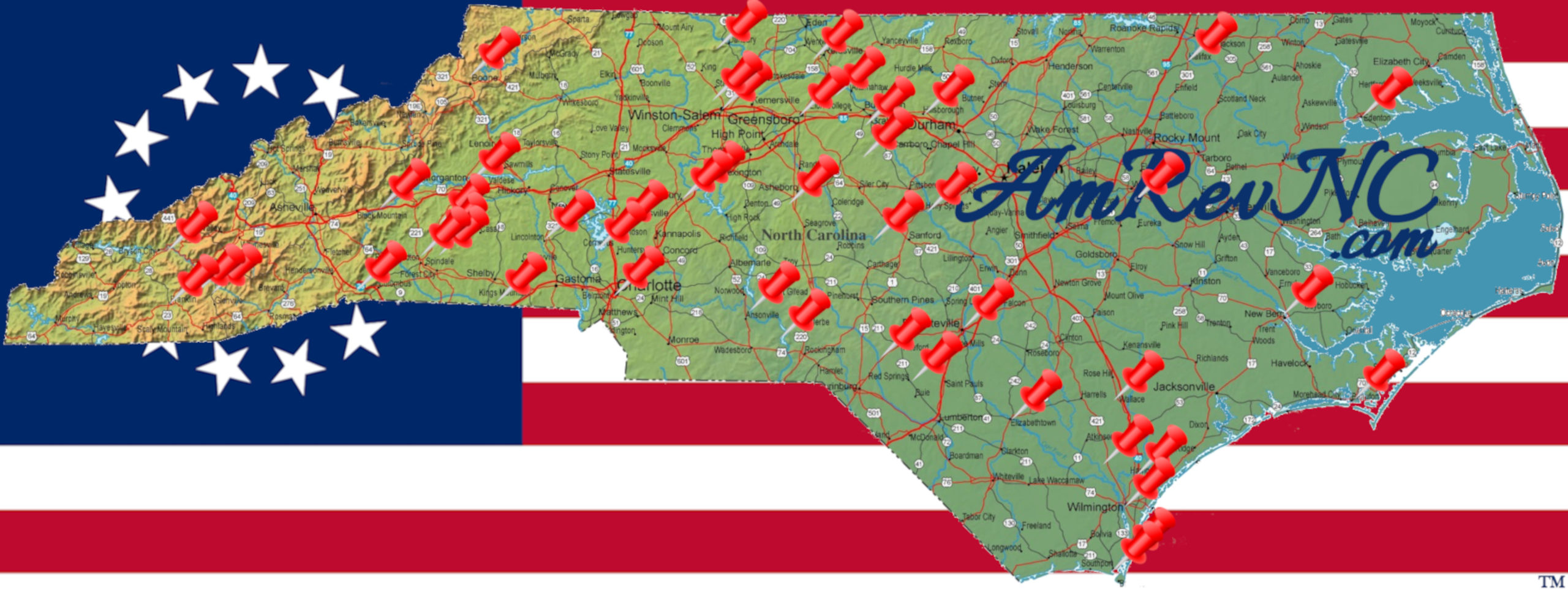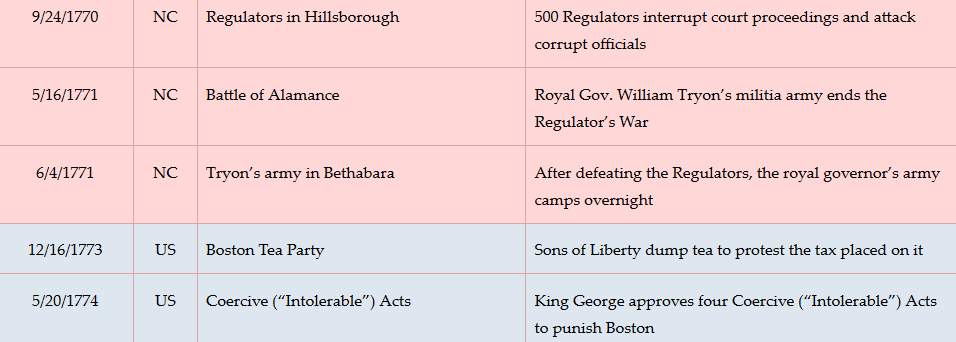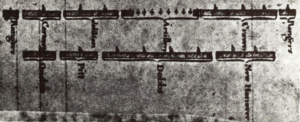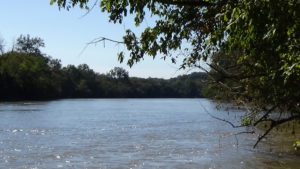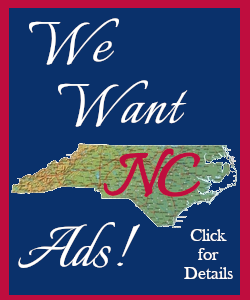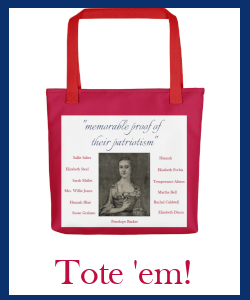A Village Hosts Armies and Prisoners
Location
Other maps: Bing, Google, MapQuest.
Coordinates: 36.1558, -80.2973.
Type: Sight
Tour: Wachovia
County: Forsyth
![]() Difficult
Difficult
We start our tour at the Visitors Center for Historic Bethabara Park. If the center is open, drop in for a map; exhibits on the broader history of the community and Moravian lifestyle, including slavery; and dioramas that bring the town to life.
Most of the tour stops cannot be easily seen from a vehicle. The ground is relatively flat but unpaved, presenting a challenge to some people with mobility issues.
Context
 The first settlement of the Unitas Fratrum or “Moravians” in their new 98,000-acre “Wachovia Tract,” Bethabara (“beth-A-ba-ruh” or “-AB-a-rah”) has become a farm community by the time of the American Revolution.
The first settlement of the Unitas Fratrum or “Moravians” in their new 98,000-acre “Wachovia Tract,” Bethabara (“beth-A-ba-ruh” or “-AB-a-rah”) has become a farm community by the time of the American Revolution.
Situations
The Regulators
Eleven years before the Revolution, European-Americans in the western half of today’s North Carolina were upset with tax policies they felt favored the eastern half; unfair court fees and land practices; and corrupt county officials. Their protests moved from petitions to violence as nothing was done to correct the problems. In 1771, Royal Gov. William Tryon marched a volunteer army from New Bern and defeated these “Regulators” at the Battle of Alamance (southwest of Burlington) on May 16. He then continued to the Trading Ford near Salisbury to free volunteers trapped by Regulators there.
The Overmountain Campaign
At the Battle of King’s Mountain (S.C.), Patriots defeated a British and Loyalist militia force and captured 800 men. Most were paroled—allowed to go free in exchange for promising not to fight anymore—or escape. But 180 prisoners and their guards arrived here.
Moravians
More Moravians came to Wachovia, mostly from Pennsylvania, and established a thriving commercial district centered on Salem (now Old Salem). However, by 1775, people throughout the state were dividing into rebels (Patriots or “Whigs”) and supporters of the king (Loyalists or “Tories”). Refusing to fight, the Moravians tried to stay neutral and serve everyone equally. They were abused by each side for helping the other.
Unless otherwise noted, all quotations and specific details on this page come from single sources in the Records of the Moravians in North Carolina, primarily the official diaries of the town for each year (see “More Information” below).
Dates
Tuesday, June 4, 1771–Thursday, February 10, 1781.
Timeline
Imagine the Scene
The Regulators
Go to the right of the reconstructed palisade (log wall). The original palisade was built for protection from Native American attacks during the French & Indian War of the 1750s. It had been torn down by the 1770s.
 Look downhill past the Community Garden to the reconstructed buildings below it. This is where the first 11 Moravian men sent from Pennsylvania to settle in Wachovia built their base of operations for creating the rest of the town. The foundation on the far left is from the 1754 town tavern.
Look downhill past the Community Garden to the reconstructed buildings below it. This is where the first 11 Moravian men sent from Pennsylvania to settle in Wachovia built their base of operations for creating the rest of the town. The foundation on the far left is from the 1754 town tavern.
Although the Moravians stayed neutral in the War of Regulation as well, their Records report that “Regulators came often to Bethabara, and disturbed the residents with threats and abusive words…” When Tryon is marching to confront the Regulators, “daily they came noisily into the town, especially to the tavern and the store, and generally had to be supplied with food and drink, and their blows and boasting were almost unbearable.” After Tryon routs the Regulators, some of the survivors come through town—including their well-known supporter Herman Husband, though no one realized it until later thanks in part to the alias he uses: “Toscape Death.”
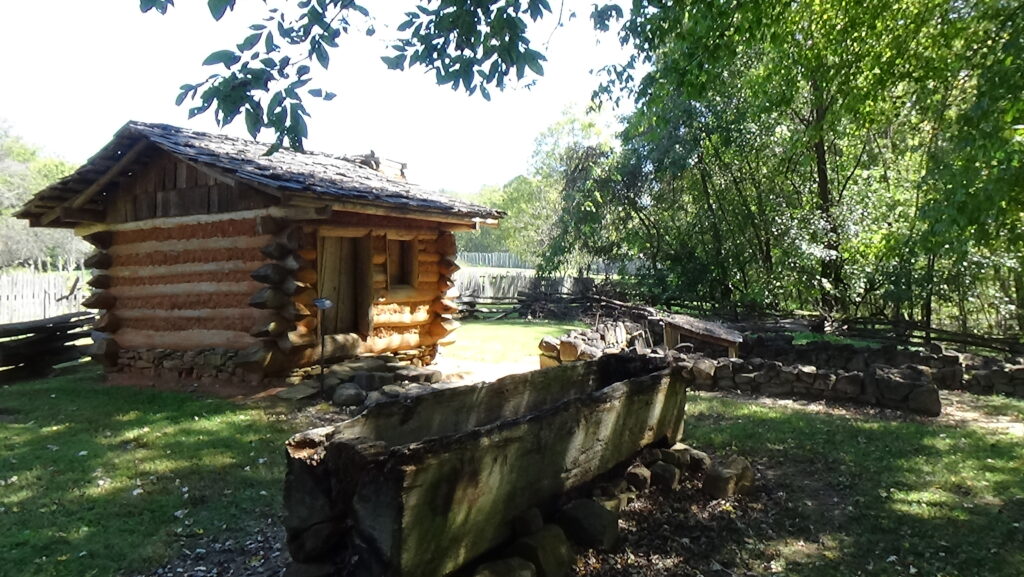
Go to the foundation closest to the road, ahead of you outside the palisade. This was the Tailor’s House.
 Two weeks later, a messenger rides into town with disturbing news: Tryon and his army are coming here! The governor arrives with some officers around noon on Tuesday, June 4, 1771, from the south (to the right if facing the road). He is shown to the Fockel/Oesterlein House, probably the “Tailor’s House” here.[1] He had been here before, having visited Bethabara with his wife earlier in his term and stayed in this home. He dines in the Single Brothers’ House[2] (visited later).
Two weeks later, a messenger rides into town with disturbing news: Tryon and his army are coming here! The governor arrives with some officers around noon on Tuesday, June 4, 1771, from the south (to the right if facing the road). He is shown to the Fockel/Oesterlein House, probably the “Tailor’s House” here.[1] He had been here before, having visited Bethabara with his wife earlier in his term and stayed in this home. He dines in the Single Brothers’ House[2] (visited later).
The rest of the army of nearly 1,300 men marches in around 5 p.m. to what Tryon names “Moravian Camp.” The town diary reports that the “men complained much of hunger, and soon not a bit of bread remained in the bakery nor in any house.”[3]
Some troops camp between the town here and the mill, which is down the greenway trail beyond the tavern. Others park themselves “in the adjacent fields and meadows,” and the horses are placed together in a large meadow on the far side of the mill along the road to Bethania to the north.[4] As has happened often on their march, all are rained on that night.
In Tryon’s orders, letters, and journal from the campaign,[5] he says “the Soldiers are recommended to Wash up their Cloathes (sic) that they may appear clean on Thursday next…”[6] While they are in town, he writes (unless otherwise footnoted):
- Wednesday, June 5: His recommendation yesterday related to orders he issues today for a delayed celebration on Thursday of, “His Majesty’s Birthday and the Victory obtained over the Rebells (sic) the sixteenth of May.” King George III was born on June 4, 1738. That evening Tryon attends a music service in the Gemein Haus (also visited later), along with other officers.
- Thursday, 6: The force assembles with weapons at 10 a.m. and marches to “the Field above the great Barn,” led by town musicians “playing on the trombones and violins.”[7] The barn was across Bethabara Road from the Tailor’s Shop, so the field is to the left on that side, between the Visitor’s Center and Bethania Station Road today.[8] Then:

Alamance battle formation from Tryon’s journal (Powell 1980) They re-create the two lines they used in the Battle of Alamance, with Waddell’s troops (those rescued from Salisbury) added on the left ends. Their artillery are placed as in the battle, too: a three-pounder, named for the size of ball it shot, on each end, and six half-pound “swivel” cannons in the middle of the first line.
- At noon they fire a 21-gun salute in honor of the king’s birthday. Gen. Waddell then yells, “God Bless the King!” That is followed by three cheers, and several songs by the Moravian band. Next they celebrate the victory at Alamance with three rounds of, in this order: two volleys from all of the artillery; a running musket volley, starting on the first line’s right end, running down to the left, picked up by the left of the second line, and back to its right; three cheers by all; and the band playing “God Save the King.” After the last cheer, hats are flung into the air.
- Having learned Waddell’s men never took the loyalty oath required of the rest of the army, Tryon goes to their end of the lines and administers it. The troops then march past him by platoon in review and back to camp. The event lasted two hours.[9]
- Afterward, they receive finished bread instead of just flour, and “a pint of Beer and Gill of Spirits per Man.”
- Friday, 7:
- A “war council” of Tryon, his officers and advisors decides to have a detachment under Waddell march west to put down any remaining rebellion in Rowan and Tryon counties. When he feels that has been accomplished, he can release the militia to return home. A later report in the town diary indicates he marches to the headwaters of the Catawba without opposition.[10]
- Apparently there has been trouble with sex: Tryon orders that “Stone Horses” (breeding males) are not to be freed amongst the other horses, are to be removed from the army, and no others are to be pressed into service!
- Saturday, 8:

Shallow Ford island is to the right, east bank to the left (AmRevNC photograph) Waddell marches out toward Shallow Ford[11] over the Yadkin to the west, with 600 men, half the army’s ammunition, and all of the artillery except a three-pounder.
- The primary merchant in Bethabara, Traugott Bagge, submits a bill for 160 gallons of beer, 160 of whiskey, and miscellaneous items including: firewood, a “blank book,” an anvil, and two deserters![12] The latter, from Waddell’s force, had been brought to town on the 1st and escorted by two Moravians back to him.[13] Tryon’s secretary complains the bill is too low, only covering what he requested to take with the army.
- Tryon visits God’s Acre, the village cemetery.[14]
- Sunday, 9: The army leaves to the south at 6 a.m., headed for Hillsborough. Tryon leaves at 9 after saying good-bye to the Sisters (Moravian women) gathered at our next stop, where “his face showed as much emotion as though he were bidding farewell to his own family.”[15] (See Tryon’s March for what happens next.)
During the period, “Many of the Regulators were brought in as prisoners, others surrendered themselves, and each was forced to swear allegiance to the King before he was released, this taking place under a shed where the day-laborers generally ate,” probably near the barn. The town diary adds, “The forty prisoners were bound two and two, and were a pitiful sight as they marched in.”[16]
Militias Make Trouble
Walk back toward the front part of the reconstructed palisade.
Continue to the foundation sticking through the palisade. This building was part of the community store abused by the Regulators, along with the closest foundation inside the wall.
 By the Revolution, many of the residents of Bethabara, and even some of the buildings, have moved to Salem. For most of the war, Bethabara sees little direct effect. However, it has its moments.
By the Revolution, many of the residents of Bethabara, and even some of the buildings, have moved to Salem. For most of the war, Bethabara sees little direct effect. However, it has its moments.
Part-time “militia” soldiers from both sides pass through the Moravian towns with some regularity. Thursday, February 8, 1776, Bethabara is “’frightened by men wearing buck-tails in the hat, presumably from Capt. Waldham’s Company which had been roughly treating people on the Atkin (Yadkin River)…’”
Some “sisters” from here visit Salem on Sunday, September 5, 1779. They report, “There is much distress in Bethabara, for 300 soldiers from Virginia are there, where they do as they please.”
The next month, 200 under a Captain Smallwood arrive on Friday, October 15, joined a day or two later by “some hundreds of infantry arrived from Dan River” in Virginia. Imagine at least 500 strangers camped in and around this tiny town. By the 17th, “All these troops had been in Bethabara for two or three days, and had eaten all the food there; and here they did not find enough bread left in the Bakery that each might get a little, and so they marched on to the Atkin.”
Continue inside the palisade to the bell in the middle. You are in the town square.
 During Tryon’s visit, his large headquarters tent is set up in the square. After the celebration described earlier, he and his officers hosted four of the town leaders including Bagge. They exchange short addresses of thanks and well wishes, and then have dinner. Then, the diary says, “when it was quite dark His Excellency set off rockets in front of his tent. The windows looking on the Square were illuminated.”[17]
During Tryon’s visit, his large headquarters tent is set up in the square. After the celebration described earlier, he and his officers hosted four of the town leaders including Bagge. They exchange short addresses of thanks and well wishes, and then have dinner. Then, the diary says, “when it was quite dark His Excellency set off rockets in front of his tent. The windows looking on the Square were illuminated.”[17]
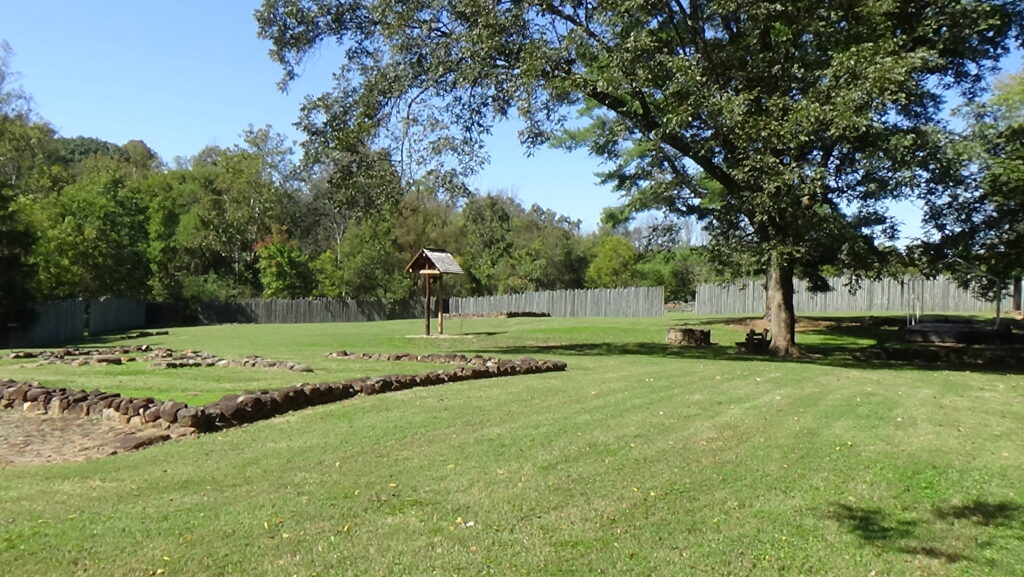
Patriot militia settle into Bethabara in the summer of 1780, as the “Tory War” between partisans of the two sides is ramping up. Among them are Col. William Campbell with 300 Virginia riflemen, and Col. Benjamin Cleveland with his Wilkes County “Bull Dogs,” as Whigs call them—or “Devils,” per the Tories. These units scour the area for Loyalists. On Tuesday, September 5, 18 are brought back here. Tory Capt. Nathan Read is sentenced by Cleveland to hang in the square, upsetting the Moravians. The Whigs agree to move the place of execution, and march all of the prisoners “‘to the middle bars of the field…’” This might have been near the brewery/distillery, viewed later.[18] There, “‘As (Read) stood at the foot of the gallows he said that he deserved this sentence, and ought to die quickly.’” He had refused to join the Patriots to gain a pardon.
The next day Cleveland rings the square with Whigs, and tries the other prisoners here. Several are whipped, one receiving a hundred lashes. The townspeople are glad to see them go the next day.[19]
About a month later Loyalists are back, in force. Between 350 and 500 muster here under Col. Gideon Wright, answering a call to meet the British army now in Charlotte as it marches north. They head on horseback for Shallow Ford, which crosses the Yadkin almost directly west, planning to raid Patriot homes along the way.

A rainy night on October 15 saw the first arrival of the Patriot militia who had fought at the Battle of Shallow Ford the day before—and routed Wright’s force. The men “‘were so cold and wet that we had to be made to get them under shelter and where they could have fire. At the time cattle had to be killed and bread baked for them.’” More trickled in overnight, and a larger force that had barely missed that battle the next day appeared from Salisbury, most on foot. Thus around 600 men are here “‘asking for bread and meat from us,’” and also “‘stealing or demanding a tithe (donation) of swine, chickens, sheep, ducks, and geese and the spring house (is) emptied of the milk and the small amount of butter.’”[20]
Go to the foundation to the right of the bell, the Single Brothers House.
 As mentioned, Tryon has dinner in the “saal” of this house, a combination dining hall and assembly room. His war council met here as well when deciding to send Waddell west, meeting all morning.
As mentioned, Tryon has dinner in the “saal” of this house, a combination dining hall and assembly room. His war council met here as well when deciding to send Waddell west, meeting all morning.
Around 300 prisoners arrive down the road (from the north), on Monday, October 23, 1780, guarded by about twice that number of Patriot militia. They are returning from the major Patriot victory at the Battle of King’s Mountain (S.C.), which stopped the British invasion. The Salem Diary reports: “Four Brethren from (Salem) were sent to Bethabara, to assist in the work caused by the arrival of a large number of soldiers and prisoners; all of them and their horses must be taken care of, and no notice had been sent in advance. Everything was in confusion…”
The Tories are apparently placed in the north side of the same meadow Tryon’s horses had used, its corn hurridly harvested the day before for that purpose. They “were placed like cattle in a small, fenced-off space, where they spent 19 days and nights, and nearly starved.”[a] Twenty British soldiers are housed here in the Single Brothers House. British officers among the captives are lodged in homes and buildings in town. Into that of British Lt. Anthony Allaire and surgeon Uzal Johnson bursts a Patriot captain on Friday night. “He strutted about in a truly coward like manner with his Sword drawn and threatening to Murder us,” Johnson records, and Allaire goes to get help. Col. Campbell, made commander of the Overmountain Men during the campaign, intervenes.[21] However, as was the military custom of the day, British and Tory militia officers are generally allowed to roam, accompanied by guards, some visiting Salem.
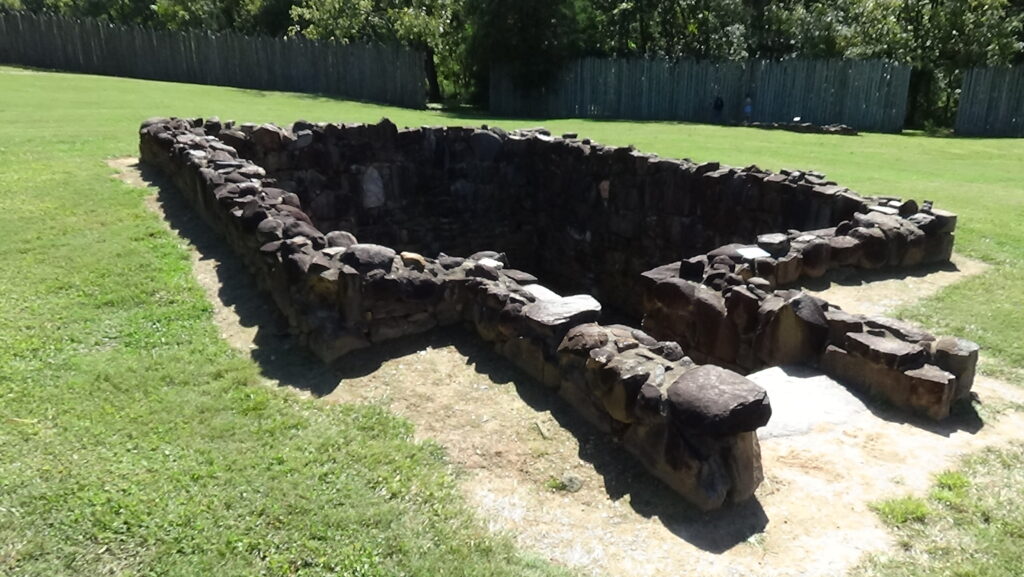
Johnson treats men from both sides, as he has since the battle. Nonetheless, a week later, Cleveland insults and knocks him down for treating a Tory with a fresh sword cut from a malicious Patriot captain. Allaire, threatened by the same man, claimed in his memoir that the Patriots would sometimes wander among the prisoners and abuse them with swords.[22] Given these incidents, it is not surprising that on November 5th, Allaire and a few others make their escape.
Another set of 180 western N.C. Tories is turned over for trial by the local militia to civil authorities, at their request. (This so angers the southern Continental commander in Hillsborough, Maj. Gen. Horatio Gates, he later threatens the militia commander with a court martial.)
The Great Escape
Continue past the bell and toward the far (left) side of the palisade. Notice the foundation of the 1756 Gemein Haus (“Community Hall”) on the left that was in use during all of these events. Pronounced “ge-MINE-house,” this was a combination sanctuary and town meeting hall typical of Moravian towns at the time. Continue past the palisade and stop at the foundation of the 1763 Apothecary behind the later Gemein Haus—the pharmacy of its day.
Various buildings would be used as schoolhouses[23], but the apothecary’s home is thought to have been used as a girl’s school also, so perhaps this is where the next incident happened.
 Two days after Allaire’s escape, on Sunday, November 7, 1780, the Bethabara Diary reports: “This morning a man was brought from the camp; he had been shot in the body through the carelessness of another man, and appeared to be in a serious condition. The man, whose name was Schmidt, was laid in the little school-house, and the English officer had to move out. Preparations were made for leaving; it was said that all the prisoners from this province who were fit for military duty had enlisted (with the Patriots under parole), so only the English soldiers were left, and the Militia from South Carolina… A company of sixty cavalry arrived this evening and remained in the tavern over night.” The tavern was not large enough to sleep that many, so perhaps their officers stayed there—or they were drinking all night!
Two days after Allaire’s escape, on Sunday, November 7, 1780, the Bethabara Diary reports: “This morning a man was brought from the camp; he had been shot in the body through the carelessness of another man, and appeared to be in a serious condition. The man, whose name was Schmidt, was laid in the little school-house, and the English officer had to move out. Preparations were made for leaving; it was said that all the prisoners from this province who were fit for military duty had enlisted (with the Patriots under parole), so only the English soldiers were left, and the Militia from South Carolina… A company of sixty cavalry arrived this evening and remained in the tavern over night.” The tavern was not large enough to sleep that many, so perhaps their officers stayed there—or they were drinking all night!
Monday, news comes that soldiers would leave the next day. English officers are told “they will go to the lead mines (in Virginia). The English are much perturbed. Br(other) Bonn and his assistant Dixon came to see the wounded man and to bandage him, the English doctor also being present. It was suspected that the English soldiers were planning to escape, and their captain notified the officer in command, who ordered a watch set before the Brothers House.”
It doesn’t work. The next morning, they are gone. “At noon all our houses were searched, but none of them were found hidden there. The cavalry sent to look for them soon returned. In the afternoon the English officers were ordered out, and after standing in front of the tavern for two hours they were joined by the Tory officers from the camp and those who did not wish to enlist… The one hundred and forty Tories of the South Carolina militia who had enlisted were released, and spent the night here in the town, building many fires on the square so that they could bake and cook. The poor men had a pitiful appearance, most of them having no clothes on their bodies. There could be no church service this evening.”
Finally, on Wednesday, the saga is over. The troops and remaining prisoners march away, actually headed to Hillsborough, and people set to thoroughly cleaning their houses. The wounded man, however, passes away, and is buried in Strangers God’s Acre the next day.
Two days later, the mystery of the missing officers was solved, though no one here knew it yet. They showed up in Salem escorted by a local Loyalist force, which must have arranged the escape.
Cornwallis Passes Through
Return to the modern roadway and look to the left.

 By far the largest force appears a few months later: the full British army of the south under Lt. Gen. Lord Charles Cornwallis. Bethabara’s news of its arrival in the area came in the form of yet more demands on Wednesday, February 9, 1781: “about eleven o’clock, a company of English dragoons arrived, bringing an order from Lord Cornwallis, for brandy, meat, meal and bread, and instructions that our mill should grind all it could, and that in the afternoon our wagon should take it to Bethania, where there were more than seven thousand men. In the afternoon the Commissary came for 100 gallons of brandy, more than 300 lbs. of bread, and all the meal that was ready… Then came a company of German Tories, with an order for cattle for the army.”
By far the largest force appears a few months later: the full British army of the south under Lt. Gen. Lord Charles Cornwallis. Bethabara’s news of its arrival in the area came in the form of yet more demands on Wednesday, February 9, 1781: “about eleven o’clock, a company of English dragoons arrived, bringing an order from Lord Cornwallis, for brandy, meat, meal and bread, and instructions that our mill should grind all it could, and that in the afternoon our wagon should take it to Bethania, where there were more than seven thousand men. In the afternoon the Commissary came for 100 gallons of brandy, more than 300 lbs. of bread, and all the meal that was ready… Then came a company of German Tories, with an order for cattle for the army.”
At 8 a.m. the next day, the army itself appears from their overnight stay at Bethania, actually about 2,000 men. They march from left to right toward Salem. It takes six hours for the Redcoat infantry, dark-green-coated German mercenaries, lighter green-coated cavalry, several cannons, a small number of wagons, and camp followers including people escaping slavery to pass through. The British post guards at the tavern and the distillery, probably on the same foundation on which the current 1802 building stands, the last building across the road to your right.[24] Other guards prevent civilians not with the army from coming into town. “Lord Cornwallis and several gentlemen were pleased to dismount; several of us waited upon him and he was friendly and seemed satisfied,” the diary says.
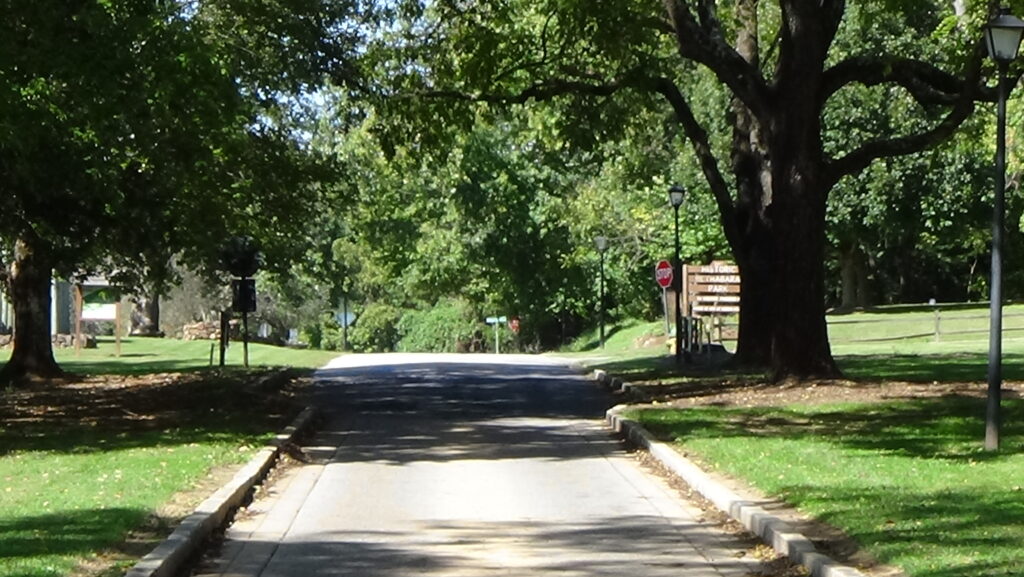
Cornwallis was chasing the Continental Army of Maj. Gen. Nathanael Greene in what now is called “The Race to the Dan.” Greene is camped at Guilford Court House in modern Greensboro. Militia armies from both sides pass through town more frequently in this period, sometimes without incident, and other times taking food or property. For example, three days after the British passed through:
“Major (Joseph) Winston arrived with a company of (Patriot) militia. Men and officers were friendly and behaved well, though we must supply them with bread, meat, meal, brandy, and forage for their horses. Late in the evening they left the town and camped in the woods, returning early in the morning to get corn for their horses. No requisition was made for the men, but the soldiers came asking for bread. Some paid for what they took, most of them did not, and all the bread baked last night was used. In spite of protests they took five horses, and would have taken more if they could have found them.”
The Moravian towns are also treated as hospitals in this period. For example, after the Battle of Clapp’s Mill near today’s Burlington on March 4, one resident described passing some wounded Patriots headed this way on the Salem road, “‘many with empty horses…’”[25]
However, the town diary records no other major incidents related to the war. The primary action moved east, and Patriot militia came to dominate this region, bringing relative peace.
More Information
- Babits, Lawrence, and Joshua Howard, Long, Obstinate, and Bloody: The Battle of Guilford Courthouse (Chapel Hill: The University of North Carolina Press, 2009)
- Draper, Lyman Copeland, King’s Mountain and Its Heroes: History of the Battle of King’s Mountain, October 7th, 1780, and the Events Which Led to It (Cincinnati: Peter G. Thomson, Publisher, 1881) <http://archive.org/details/cu31924032752846> [accessed 31 March 2020]
- Fries, Adelaide L. ed., Records of the Moravians in North Carolina. Volume I: 1752-1771 (Raleigh, N.C.: Edwards & Broughton Print. Co., 1922), <http://archive.org/details/recordsofthemora01frie> [accessed 14 October 2020]
- Fries, Adelaide L., ed., Records of the Moravians in North Carolina (Raleigh, N.C.: Edwards & Broughton, 1922), Volume 2: 1752-1775 <http://archive.org/details/recordsofmoravia02frie> [accessed 17 March 2020]
- Fries, Adelaide L., ed., Records of the Moravians in North Carolina. Volume III: 1776-1779 (Raleigh, N.C.: Edwards & Broughton, 1926), iii <http://archive.org/details/recordsofthemora03frie> [accessed 17 March 2020]
- Fries, Adelaide L., ed., Records of the Moravians in North Carolina. Volume IV: 1780-1783 (Raleigh, N.C.: Edwards & Broughton, 1930), 4 (1780-1783) <http://archive.org/details/recordsofthemora04frie> [accessed 19 March 2020]
- Historic Bethabara Park, Exhibits (Winston-Salem, N.C., 2020)
- Johnson, Uzal, Uzal Johnson, Loyalist Surgeon: A Revolutionary War Diary, ed. by Bobby Gilmer Moss (Blacksburg, S.C: Scotia Hibernia Press, 2000)
- Jones, Randell, Before They Were Heroes at King’s Mountain, North Carolina/Tennessee Edition (Winston-Salem, NC: Daniel Boone Footsteps, 2011)
- Lewis, J. D., ‘Bethabara, North Carolina’, Carolana, 2007 <https://www.carolana.com/NC/Towns/Bethabara_NC.html> [accessed 24 April 2020]
- Overbey, Diana, Historic Bethabara Park, Phone interviews and e-mails, 10/2020
- Powell, William Stevens, ed., The Correspondence of William Tryon and Other Selected Papers (Raleigh, N.C.: Division of Archives and History, Dept. of Cultural Resources, 1980) <http://archive.org/details/correspondenceof1981tryo> [accessed 16 November 2020]
- Sherman, Wm. Thomas, Calendar and Record of the Revolutionary War in the South: 1780-1781, Tenth Edition (Seattle, WA: Gun Jones Publishing, 2007) <https://www.americanrevolution.org/calendar_south_10_ed_update_2017.pdf>
- ‘Welcome to Historic Bethabara’ <https://historicbethabara.org/> [accessed 24 April 2020]
[1] Overbey 2020.
[2] Fries 1922.
[3] Ibid.
[4] Probably where Beacon Drive and Pioneer Trail are today (Overbey 2020).
[5] Ibid.
[6] Powell 1980; all remaining Tryon information comes from this source unless otherwise footnoted.
[7] Fries.
[8] Overbey.
[9] Fries.
[10] Ibid. Given the patterns of European-American settlement at the time, it seems unlikely they went that far west; perhaps this refers to Quaker Meadows, now Morganton, on the Catawba.
[11] Ibid.
[12] “Receipt for payment in full” from Bagge (in Powell). He later moved to Salem, where his name still appears on the Old Salem store.
[13] Fries.
[14] Ibid.
[15] Ibid.
[16] Ibid.
[17] Ibid.
[18] Overbey.
[19] September 5–6 events: Jones 2011.
[20] Quoted in Jones.
[21] Quote from Johnson 2000; Campbell from Draper 1881.
[22] Ibid.
[23] Overbey.
[24] Ibid.
[25] Babits and Howard 2009.
[a] Editor’s note in Johnson.
← Bethania | Wachovia Tour | Salem →
